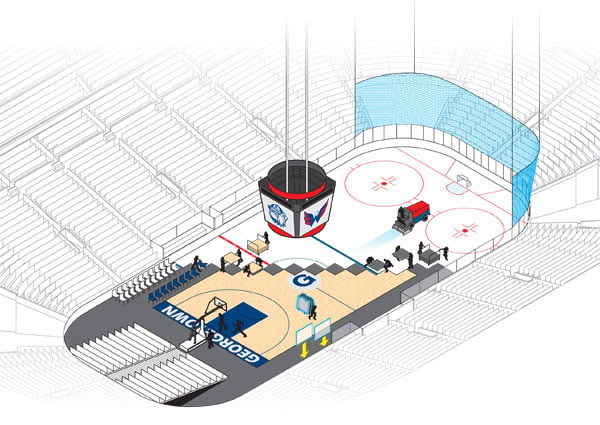Illustration by Chris Philpot.
When the Georgetown Hoyas and Washington Caps play home games the same day, the athletes aren’t the only ones under pressure. Verizon Center vice president of operations Bill Harpole and his crew have less than three hours to turn the basketball court into a hockey rink. Here’s what happens.
2:00 pm
Shortly after the basketball game ends, the operations crew collapses the goals and removes the courtside chairs. Seat sections behind the goals are replaced with rows better suited for watching hockey. The building temperature is lowered from 68 to 60.
2:45 pm
The 245 pieces of wood flooring that make up the basketball court are unscrewed and carried off. The basketball goals are then removed.
3:15 pm
Sheets of plexiglass—used to protect fans from pucks—are slotted on top of the hockey boards surrounding the ice. Seats are taken away to clear the penalty boxes, the team boxes, and the tunnels leading from the players’ dressing rooms to the ice.
4:15 pm
The crew takes up the more than 500 pieces of insulated flooring, exposing the ice. (The ice remains frozen under the Verizon Center floor for all events except the Washington International Horse Show.) Using an underground network of coils, the ice temperature is lowered from about 22 to 18. Additional seats are moved into the corners of the stadium.
4:45 pm
The ice is swept for trash and edged to remove buildup. Employees use water to repair holes that have developed in the ice. The ice is then resurfaced.
4:55 pm
Protective netting is lowered from the ceiling and attached to the plexiglass sheets behind the hockey goals.
5:00 pm
The ice rink is ready.
7:00 pm
The game begins.
This article appears in the February 2012 issue of The Washingtonian.



















